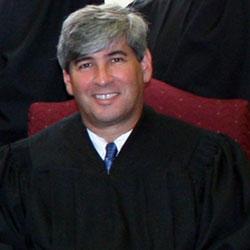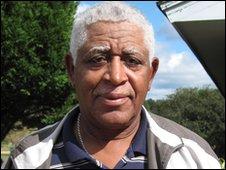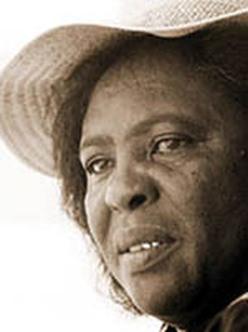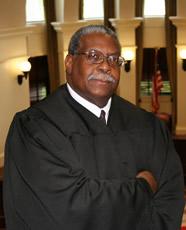
Doug Evans questions witness Clemmie Fleming
By Alan Bean
Is it a crime to kill a nigger in Mississippi?
At the risk of offending right-thinking people everywhere, I will ask the appropriate question in the appropriate way: “Is it a crime to kill a nigger in Mississippi?”
If the Supreme Court’s decision to uphold the 2010 conviction of Curtis Flowers is any indication, the answer to this distressing question is still “no”.

Bill Waller as Mississippi Governor
My offensive framing of the question hails back to the 1964 trial of Myron De La Beckwith, the man accused of killing civil rights leader, Medgar Evers. Prosecutor Bill Waller was tasked with the thankless task of prosecuting a man who was being hailed as a hero in his home town of Greenwood, Mississippi. To have any chance of attaining a conviction, he had to signal to the courtroom that he shared their disapproval of Medgar Evers and the movement he symbolized; he also had to find twelve men (women didn’t serve on Mississippi juries in 1964) who believed it was a crime for a white man to kill a black man. So every prospective juror was asked the same question. Here’s how it went the first time round.
“Do you think it’s a crime to kill a nigger in Mississippi?” Waller asked one potential juror.
After a long silence, the judge demanded an answer.
More silence.
“He’s thinking it over,” Mr. Waller said.
The African Americans in the gallery gasped and moaned in dismay every time the hated word was uttered, but Waller got the jury he was looking for.
Little has changed. Prosecutors and defense attorneys must still adapt to the prejudices and perceptions on display in the courtroom if they hope to have any chance of success.
As things presently stand in Mississippi, Supreme Court justices must also learn to dance with them that brung ‘em. The state Supreme Court that reversed three earlier Curtis Flowers convictions no longer exists. The only holdover from the court that handed down the last reversal is Bill Waller Jr, the son of the man who asked the “nigger question” back in 1964. Bill Jr. was twelve years old when his father asked his infamous question. He may even have been sitting in the courtroom.
The last time Bill Waller ruled on the Flowers case he voted, with the majority, to overturn the conviction. In 2014, Waller voted, again with the majority, to uphold the conviction. The case hasn’t changed; but the legal landscape of Mississippi has been transformed.
When the Flowers case first came before Mississippi’s highest court, trial lawyers, overflowing with cash earned by defending litigants against corporate criminals, were pouring millions of dollars into Mississippi politics. Most of that money went to the Democratic Party, and a goodly portion backed moderate candidates for the Supreme Court. There was no sense winning a massive settlement only to have the ruling overturned.

Oliver Diaz
Oliver Diaz, the Supreme Court’s most outspoken critic of the racial bias on display in the Flowers case, lost his seat on the court in 2008 after a politicized Justice Department made two failed attempts to convict him on bogus charges of corruption. Then, in a campaign the Jackson Clarion-Ledger has called one of the dirtiest races in state history, Diaz was defeated by Randy “Bubba” Pierce. Groups affiliated with the National Rifle Association flooded the airwaves with ads claiming that Diaz was “voting for” both a rapist and a “baby killer.”
Diaz had actually dissented in a case in which the majority barred DNA testing and another in which he thought the state decision should wait until the U.S. Supreme Court had a chance to rule. (The travails of Oliver Diaz, by the way, inspired John Grisham’s The Witness and are also highlighted in the HBO documentary, Hot Coffee.)
No one on the Mississippi Supreme Court wants to be accused of “voting for” the guy who killed four people in cold blood in a Winona furniture store. And that is precisely what Flowers is accused of doing. DA Doug Evans has won easy convictions from white jurors by appealing to race-related anxieties and prejudices.
If you can keep enough African Americans off the jury it is easy to convict Mr. Flowers; if you let too many African Americans on the jury it is impossible to secure a conviction.
Just as Bill Waller Sr. worked hard to keep racists off his jury, Doug Evans has gone to extraordinary lengths to get them on.
Will witnesses now be getting their $30,000 rewards?
Now that the Mississippi Supreme Court has upheld the conviction of Curtis Flowers, will the folks who testified against him at each of his six trials get their $30,000 rewards?
Back in 1996, a handful of people living on the poor side of a poor town were offered more money than they had ever laid eyes on in exchange for the right answer to a simple question, “Did you you see the man in this picture the morning four people were murdered at the Tardy Furniture store?”
Not everyone got a shot at the big money, only those who lived along the route Curtis Flowers had to walk on the fateful morning . . . if the state’s theory of the crime was anything to go by. Most of the people who saw the picture shook gave the wrong answer. Months had passed, after all, and who could remember who walked past the house on a random morning? Two decades later, the wrong answer feels like a God-send.
If you flash that much money on the poor end of any southern town you will get some takers. The potential reward recipients won’t be an impressive crew. They certainly haven’t been in the Flowers case.
One woman had to be released from a mental hospital so she could testify.
Four family members of another witness insist she was with them when she says she saw Mr. Flowers fleeing the scene of the crime.
And then there is the state’s star witness, Patricia Hallmon Sullivan, who recently completed a long stretch in federal prison time for failing to slip over $300,000 in fake deductions past the IRS. Patricia’s moral foibles must be overlooked. Her testimony gave investigators their timeline and theory of the crime. You can read more about the felonious Patricia and her career-criminal brother, Odell, in earlier posts.
You can’t make this stuff up.
No reward money has ever been paid out because the state has never secured a “final conviction” against Curtis Flowers. Until now, that is. Flowers can still take his case to the federal court system, but Mississippi has spoken.
After eighteen years, two hung juries, and three three Supreme Court reversals, District Attorney Doug Evans finally has a “w”. Earlier convictions had been overturned because the DA from Granada, Mississippi misconstrued trial testimony during closing statements and demonstrated racial bias during the jury selection process.
Evans repeated these sins in the sixth trial, but this time he got a pass.
An investigation shaped by racial politics
Friends of Justice has been following this case since it first came to our attention in 2007. For the past fifteen years we have been saying that the judicial system is distorted by racial bias, especially in small southern towns, and most particularly in cases where the evidence is ambiguous. The Flowers case provides the perfect illustration of how things go wrong.
To understand the investigation and prosecution of Curtis Flowers you must understand the racial history of Mississippi. On the morning of July 16, 1996, four innocent people lost their lives: owner, Bertha Tardy, business manager, Carmen Rigby, and two new hires, Derrick “Bobo” Stewart and Robert Golden. The victim were dispatched, execution style, with a bullet to the back of the head. The bodies were discovered between 9:15 and 9:30 in the morning by Sam Jones, an elderly man who had worked for the furniture store for decades. Now retired, Jones had agreed to teach Stewart and Golden how to load and unload furniture.
By the time Doug Evans arrived at the scene of the crime, two people of interest had emerged. A check for just over $80 made out to Curtis Flowers was found on Bertha Tardy’s desk. Roxanne Ballard, Bertha’s daughter, saw the name and was instantly convinced that Flowers was the killer. She had never met the man and knew nothing about him; but one look at that check and she had the crime figured out.
The second person of interest was Doyle Simpson, a part-time janitor at the Angelica garment factory about half a mile from the crime scene. Doyle had made a lunch run for several Angelica employees late that morning and had been ostentatiously broadcasting the fact that a pistol had been stolen from the glove compartment of his car earlier in the morning. Police officers were dispatched to take a statement.
Both Flowers and Simpson were interviewed early the afternoon of the crime, but trial testimony shows that, less than two hours after Sam Jones stumbled across the crime scene, Curtis Flowers was the prime suspect. Local authorities have always maintained that the gun taken from Simpson’s glove box was the murder weapon, but, curiously, Simpson lived above suspicion until, entirely without ceremony, he died.
Doug Evans, the man charged with investigating and prosecuting the worst crime in Winona history, knew that if this case went cold his career was over. A killer had to be tried, convicted and executed. And although three of the four victims were white, it was preferable, for an unholy host of reasons, that a black man take the fall.
Curtis Flowers didn’t have much of a motive for killing four people in cold blood. The state would have us believe that, enraged after being fired and having his pay docked, Flowers took his revenge on Bertha Tardy and, eager to make crime pay, he grabbed approximately $300 in cash on the way out. Considering that the state has never been able to produce a single witness claiming that Flowers was upset over his firing, this was a pretty weak motive.
But Doyle Simpson appeared to have no motive whatsoever.
If Doyle was involved in the crime, he was almost certainly working in concert with others. If he was the killer, what was the motive, and why was he telling perfect strangers all over town that his gun had been jacked?
Doug Evans couldn’t entertain Doyle Simpson as a serious suspect without asking who paid him or, alternatively, who had arranged to use his gun. Four bodies lying side to side with bullet holes in the back of their heads certainly looked like a contract hit, but if so, who might have been interested in seeing one or more of the victims dead?
Evans didn’t want to go there. Point the finger of blame at a prominent white person in Winona and bad things were sure to happen. Since Roxanne Ballard, Bertha Tardy’s daughter, seemed convinced that Flowers was the man, why look for white suspects on the prosperous side of town?
When we abandon Evans’ lone-gunman-theory, the facts of this case make more sense. It has always been hard to believe that a single person could methodically shoot four people in the back of the head without sparking the kind of panicked flight that would have left bodies here, there and everywhere. A trained killer might be able to pull it off; but Curtis Flowers (or Doyle Simpson for that matter) could not.
And then there is the testimony of “Porky” Collins to consider. (If a Supreme Court justice can be called “Bubba”, a witness gets to go by “Porky”). Collins said he was driving by Tardy Furniture at about 10:00 a.m. the morning of the crime and saw two men near a car parked on the boulevard in front of the store. One man was gesturing wildly with his hands, and Porky caught a glimpse of him as he rolled by. He never saw the face of the second man.
DA Evans, using a highly suggestive photo array, was able to get Collins to tentatively identify Curtis Flowers (more on this later), but Evans has never explained who the second man on the scene might have been. While there is strong reason to question Collins’ identification of Flowers, there is no reason to doubt the basic thrust of his testimony.
A witness who can place Flowers at the scene of the crime moments after the bodies were discovered was problematic to say the least. Since Sam Jones entered the store somewhere between 9:30 and 10:00, Jones was either inside the store or up the street calling the police when Porky made his sighting. But if the man making wild gestures twenty feet from the store was indeed Curtis Flowers, who was he talking to and why was he so agitated.
Fortunately for the prosecutor, defense attorneys have normally challenged the credibility of Porky Collins rather than working his testimony to their advantage. If the two men Collins saw were involved in the crime, we are dealing with a two-man operation at the very least.
If Doug Evans had considered more than one theory of the crime, some troubling scenarios would have warranted investigation.
 Tardy Furniture store was the life’s work of Tom Tardy. Tom was still showing up at the store to greet customers and putter about (although, mysteriously, he wasn’t present on the tragic morning) but everyone knew that Bertha, his younger and more energetic wife, was now running the business.
Tardy Furniture store was the life’s work of Tom Tardy. Tom was still showing up at the store to greet customers and putter about (although, mysteriously, he wasn’t present on the tragic morning) but everyone knew that Bertha, his younger and more energetic wife, was now running the business.
Bertha wasn’t Tom Tardy’s first wife and the children of his first marriage had never forgiven her for breaking up marriage number one. The fact that Bertha, assisted by daughter Roxanne, was now in control of the business was deeply resented by Tom’s children and everyone in town knew it.
Does that mean Tom Tardy’s kids ordered a hit on their step-mother? They certainly had a better motive than Curtis Flowers, but it still seems a stretch. Besides, with the family still reeling from shock and grief; how could an investigator ask the necessary questions of the necessary people without inviting an anguished backlash? (I have never mentioned this theory in my voluminous writing on this case and for much the same reason.) So much easier to pin the crime on an anonymous black man.
And what of the family of Carmen Rigby? Bertha Tardy’s business manager had recently left Benny Rigby, her hot-headed and controlling husband. The two weren’t formally divorced, but they were separated, and any serious investigator would have dropped by for a quick chat with Benny. That never happened.
Here’s another fact I have never mentioned. Shortly after Carmen’s tragic death, Benny Rigby began dating another Winona woman and the two were eventually married. But within months of tying the knot, wife number left town with her ten-year-old son and has never been heard from since.
Who is Benny Rigby? During Curtis Flowers’ sixth trial in June of 2010, Benny frequently harassed Friends of Justice representatives, even implying that Director Alan Bean was romantically involved with the women who were working with him. On one occasion, he became so belligerent his sons were forced to intervene. Following the trial, Benny bombarded the Friends of Justice website with scurrilous allegations for weeks.
I am not suggesting that Benny Rigby ordered a hit on his estranged wife; but his possible connection to the crime had to be investigated as a matter of course, and it wasn’t.
It is also possible that the mayhem at Tardy Furniture store was a random tragedy. During the summer of 1996, two young men in Birmingham, Alabama (just two hundred miles east of Winona on Highway 82) were caught on camera robbing and shooting innocent shop owners. The younger of the two (he was only sixteen) appears to have enjoyed killing people. His dim-witted accomplice held a gun on the victims while the crime played out to keep anyone from fleeing the scene or fighting back.
Doug Evans never inquired into a possible link between two highly publicized crimes with an amazingly similar modus operandi.
We will never know who killed Bertha Tardy and three of her employees in 1996. There was a window of opportunity during which a proper investigation could have been conducted, but the obvious suspects were never asked the obvious questions.
Instead, armed with a theory of the crime supplied by a now-convicted felon, investigators spent the better part of a year going door-to-door with a picture of Curtis Flowers and a handbill offering a $30,000 reward for information leading to a final conviction.
How Doug Evans got an (almost) all-white jury
I wasn’t particularly surprised by the Mississippi Supreme Court’s 6-3 decision. Trial number 6 didn’t lend itself to charges of prosecutorial bias because potential jurors from the African American community were desperate to avoid jury duty. They looked like deer in the headlights. One person after another proclaimed that their opposition to the death penalty or their intimate association with the Flowers family, made it impossible for them to maintain objectivity.
Asked if they could be objective, white members of the venire answered in the affirmative even if they had been good friends with one or more of the victims. This explains how a venire that was 44% African American produced a jury that was 92% white.

James Bibbs
This reluctance to serve on the jury is completely understandable. At the close of Flowers 5, James Bibbs, the man who had just hung the jury, was hauled before judge Joey Loper and charged with perjury.
In the course of trial number 5, police officers testified that they had done a thorough search of the neighborhood surrounding the Tardy Furniture store. Bibbs told his fellow jurors that he had been in the alley just down from Tardy’s all morning and hadn’t seen a single officer pass by. According to DA Evans and Judge Loper, that meant Bibbs had perjured himself when, during voir dire, he claimed to know nothing about the crime apart from what he had read in the newspapers.
When Evans and Loper were recused from case, the Mississippi Attorney General’s office quietly dropped the charges against Mr. Bibbs. Not witnessing anything hardly constituted “knowledge of the crime”. But the damage had been done and Black jurors in Winona knew what they could expect if they were unfortunate enough to wind up on the jury for Flowers #6.
In earlier trials, Doug Evans was forced to waste all his peremptory strikes on African Americans and still ended up with juries too diverse to secure a conviction. On one particularly galling occasion, all five Black jurors voted to acquit. Evans knew a jury that looked like Montgomery County would divide along racial lines. Racial perception is like that old duck-rabbit illusion where you see a duck or a rabbit, but not both at the same time. In Winona, White folks see Flowers as a cold killer; and Black folks see him as a good-hearted gospel singer who would up on the wrong side of the law.
In 2010, Doug Evans could easily have selected an all-white jury, but, thinking that might look bad, he found an African American in the jury pool with few ties to Winona’s black community and primarily white friends. In short, a man who knew his place.
How much has Mississippi changed, really?

Fannie Lou Hamer was beaten savagely in the Montgomery County Courthouse in Winona
To understand this racial divide, you need a crash course in Mississippi history. That is why our coverage of this case has frequently asked how much the Magnolia State has changed since 1963, the year Fannie Lou Hamer and several other civil rights activists were beaten half to death in the Montgomery County Jail in Winona.
Consider, for instance, the case of Lydia Chassaniol, the Mississippi State Senator who once owned a restaurant just across the street from Bertha Tardy’s furniture store. Chassaniol was surprised when the Jackson Free Press criticized her for giving the keynote address at the annual convention of the Council of Conservative Citizens, a we’re-racist-and-we’re-proud organization that emerged out of the old white Citizen Council movement. Chassaniol admitted to being a member of the organization, but said the group was organized to raise money for the state’s all-white private schools. No harm in that.
We have also noted that Doug Evans, the man who has prosecuted Curtis Flowers six times, was a popular speaker at Council of Conservative Citizen events before the group got too hot for state politicians to touch.
But the central focus of our foray into Mississippi history has been the often-overlooked years between 1970, the year Mississippi was finally forced to integrate its public school system, and the arrest of Curtis Flowers twenty-six years later. We concluded that white people in Mississippi changed their behavior, grudgingly, without undergoing a change of heart. Racial attitudes have softened, but the state’s still-recent commitment to white supremacy was never seriously examined or consciously repudiated.
The Ghosts of Mississippi still haunt the Supreme Court
In 2012, Josiah “Dennis” Coleman was sworn into office by Supreme Court Justice William L. Waller Jr. Both Waller and Coleman recently rode to the state’s supreme court on a wave of money flowing from the National Rifle Association and pro-business groups like the Chamber of Commerce.

Josiah “Dennis” Coleman
Josiah Coleman is the grandson of James P. Coleman, the governor of Mississippi who, in the wake of Brown v. Board of Education, created the Mississippi Sovereignty Commission, a network of anti-civil rights spies with close ties to the Citizen Councils, that was headquartered in the governor’s office.
Still, despite creating an anti-civil rights spy network and preaching white supremacy, Coleman is remembered as a racial moderate who would eventually surrender the governor’s mansion to a full-blooded racist named Ross Barnett. Josiah Coleman is too young to remember Mississippi’s bad old days, but it is unlikely that anyone in the young man’s social world has ever challenged him to re-examine and renounce the ingrained racism his grandfather could never escape.
Voices of dissent

Justice Leslie King
Since eight out of the nine justices on the state supreme court are self-proclaimed conservatives with ties to big business and the gun lobby, it is somewhat surprising that a third of the justices dissented from the majority decision in the Flowers case. Justices Jim Kitchens, Jess Dickenson and Leslie King (the sole African American on the Court and the only justice who didn’t graduate from Ole Miss) insist that Flowers should have received yet another trial.
King’s deep concerns about the Flowers case were evident when defense counsel presented oral arguments several months ago. King may has made his peace with white conservatism, but an African American from Greenville, Mississippi can’t avoid the questions that are rarely noticed by the sons of Mississippi governors.
As the court’s token progressive, Jim Kitchens’ concerns with the Flowers case are also understandable.
The only anomaly on the court is Jess Dickinson, an ultra-conservative justice elected to the court with generous help from the same coterie of special interests noted earlier. Dickinson has been called “a shoeshine boy for big-business” and his rulings are generally in line with this reputation. But the blue grass loving jurist appears to be that rare individual who can to love big business and the principle of equal justice at the same time. It’s not as easy as it sounds.
Not surprisingly, the most passionate critique came from Justice King, the sole African American on the court.
King was outraged that Doug Evans told the jury, as if it was settled fact, that Sam Jones arrived at Tardy Furniture at 10:00 a.m., half an hour after Jones’ actual testimony places him at the scene. King thinks Evans was up to his old tricks and wonders why defense counsel failed to object during trial.
“The statements that resulted in this Court reversing Flowers’s conviction and death
sentence in Flowers II are notably similar to the statements raised in today’s case,” King noted. “While this repetition of prosecutorial misconduct is alarming, the Majority’s approval of the same is even more startling. Courts have long recognized – and reasonably feared – that misconduct during closing argument may become commonplace in our trial courts.”
If big business and the gun lobby continue to call the tune, it well may.
The three dissenting judges also questioned the majority’s assertion that Flowers had a clear motive for a crime of this magnitude, since not a syllable of trial testimony suggests that Flowers had “a beef” with Bertha Tardy or anyone else.
Three justices would have granted another trial simply on the basis of Doug Evans’ misleading claim that Porky Collins unambiguously identified Curtis Flowers as the man he saw outside the Tardy furniture store at 10:00 am the day of the crime.
In point of fact, Collins came close to identifying Doyle Simpson (the man with the stolen gun) as the man arguing outside the furniture store. Moments later, with his finger hovering over the picture of Flowers (a head shot while the other pictures in the array were head and shoulders) an investigator asked Collins “do you know Curtis Flowers.” Taking the subliminal hint, the eager-to-please witness made an extremely tentative Identification.
But King and his fellow dissenters were particularly outraged by the blatant racial bias on display during the jury selection process. True, Evans didn’t have to work as hard this time to get the kind of jury he wanted, but he worked hard enough. King put it this way:
The same prosecutor who this Court found to have engaged in purposeful discrimination in Flowers III prosecuted the trial before this Court on appeal today. On its own, this fact is not dispositive of a finding of racial discrimination. This history, however, cannot be ignored and is part of the relevant circumstances that must be considered in this
case.
In the infamous Miller-El case, King pointed out, the court noted that the Dallas County DA’s office had a history of racial discrimination in the process of jury selection and reversed on that basis. The same history can be amply demonstrated in the Curtis Flowers saga, King argued, and nobody seems to notice. How can you charge a man with racial bias and then ask him to re-prosecute the case? People don’t change that easily.
In his dissent, Justice King argues that Doug Evans was just as determined to weed out black jurors in 2010 as he has been in previous trials. His concluding remarks reflect his frustration with this case:
As noted previously, this case has been twice reversed by this Court for some of the same issues presented to it today. In the retrial of a case under these circumstances, where
the same issues are confronted, the trial court is obligated to look beyond the surface. The trial court failed in that obligation.Because of that failure, I cannot conclude that Flowers received a fair trial, nor can I conclude that prospective jurors were not subjected to impermissible discrimination. For these reasons, I would reverse and remand for a new trial.
If the Mississippi Supreme Court had not been refashioned by gushers of money from the gun and business lobbies, Justice King’s arguments would have prevailed. But, as we have seen, the Mississippi Supreme Court is not what it once was.
This fight to free Curtis Flowers may be over in the state of Mississippi, but the legal fight has just begun. Getting the federal court system to take a case seriously isn’t easy, but when a black man in Mississippi is tried for the same crime six times, people take notice.
Is it a crime to kill a nigger in Mississippi? It appears so. Next we will see how this crude question is answered by the federal court system.
